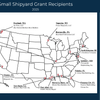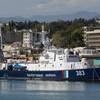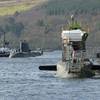WCI Meets the Press, Addresses FY 2018 Budget Request
Consolidated Appropriations Act of 2017; FY 2017 Corps' Work Plan and Infrastructure Plan Addressed.
Waterways Council, Inc. (WCI) today held its annual briefing for the news media to address the President’s FY 2018 budget request, the FY 2017 Consolidated Omnibus Appropriations Act, the Corps of Engineers’ FY 2017 Work Plan, and the Administration’s infrastructure initiative. he event was held at the National Press Club in Washington, DC.
FY 2018 Budget Request
The full FY 2018 budget request to Congress released by the Trump Administration proposes $5.02 billion for the Corps’ Civil Works program, representing a $382 million increase above President Obama’s FY17 request, but more than $1 billion below the $6.038 billion appropriated by Congress for FY 2017. This is, however, only the second time in at least the last 10 years that a President has requested $5 billion or more for the Corps.
The budget proposes $1.02 billion for the Construction account, $50 million below the previous Administration’s request, and $736 million less than Congress appropriated for FY17. No new starts were recommended in the budget proposal.
For inland waterways capital projects, the budget requests funding only for the Olmsted lock and dam project (Ohio River), with the Inland Waterways Trust Fund (IWTF) share being $26.25 million out of the $105 million that budget documents estimate will be generated in 2018 from the current 29-cents-per-gallon diesel fuel tax. Additionally, the Administration’s budget request proposes to generate $108 million in new revenue from a recycled user fee proposal previously floated by other Administrations. This is estimated in FY18 to total $213 million in IWTF income, but none of this current/new revenue will be spent beyond what is requested for Olmsted under the Administration proposal. This leads to the IWTF balance ballooning to $243 million, roughly a 400% increase, by September 30 of next year (the end of FY 2018).
“WCI seeks ‘full-use’ spending of Inland Waterways Trust Fund revenues for the many capital needs on the inland waterways and this budget request represents ‘bare use’ spending,” said Mike Toohey, WCI President/CEO. “Under this proposal, workers at three priority navigation projects – Lower Mon, Kentucky and Chickamauga – will be laid off, with additional costs incurred from shutting these ongoing projects down,” he continued.
The FY18 budget requests a substantial cut to $86 million for the General Investigations account, down $35 million from FY17 appropriated levels, and requests $253 million for Mississippi River & Tributaries projects, reduced $109 million from FY17 levels.
This budget requests $965 million be appropriated from the Harbor Maintenance Trust Fund (HMTF), a slight increase over the Obama Administration’s FY17 requested level, but significantly lower than the $1.3 billion amount appropriated in the recently-passed Omnibus act (P.L. 115-31).
A bright spot in this FY 2018 budget request was the highest-ever recommendation of $3.1 billion for the Operations and Maintenance (O&M) account; President Obama had requested $2.705 billion in FY17. However, continuing a troubling recent trend, this FY 2018 funding level means that more than 60% of the Corps’ budget request is going just to keep projects operating.
The aforementioned Office of Management and Budget (OMB) 10-year, $1.037 billion user fee to be paid by commercial operators on the inland waterways drew sharp criticism from WCI. The proposed increase would generate an amount roughly equal to what is collected from the current fuel tax, suggesting an effective doubling of the recently-enacted 29-cents-per-gallon tax. Past similar proposals have been rejected by Congress and are not supported by industry.
“How can the Administration, in good faith, ask commercial users – just one of many beneficiaries of the waterways system – to double their tax for the inland waterways when the Administration proposes to utilize only 12.3% for the purposes for which the tax is raised?,” Toohey asked. “We once again call on Congress to reject this onerous tax increase and leave it in the swamp.”
Consolidated Appropriations Act of 2017 (P.L. 115-31)
In the Consolidated Appropriations Act of 2017 (P.L. 115-31), Mr. Toohey applauded Congress for FY17 funding for the Corps’ Civil Works mission that totals $6.038 billion, a slight (0.8%) increase above the FY16 funding level, but almost a 31% increase above the Obama Administration’s requested level. The Act substantially increases funding for IWTF-funded projects.
In order to avoid incurring preventable cost increases for IWTF projects due to expiring contract options applicable to as many as three priority projects (Lower Mon, Kentucky and Chickamauga), the Corps was directed to allocate necessary funds within 10 days of enactment of the FY17 bill to the affected projects.
The bill provides $3.149 billion for the Corps’ Operations & Maintenance (O&M) account, the fourth consecutive year of record-level funding, including at least $46.5 million more in O&M funds than the President Obama-requested $631 million for inland navigation and $1.3 billion for activities funded by the Harbor Maintenance Trust Fund, which hits the WRRDA-required target.
It also provides $362 million, a $17 million increase from the FY16 level, for Mississippi River & Tributaries projects.
On Public-Private Partnerships (Ps), explanatory language accompanying the bill noted that “…until such time as a comprehensive (P3) policy is established…, the Corps shall discontinue all work on project-specific public-private partnerships beyond the P3 project selected [Fargo/Moorhead] as a new start in fiscal year 2016.”
FY 2017 Work Plan
The Corps of Engineers’ work plan for FY 2017, which allocates appropriations made available by Congress, is a very positive picture. The Construction account includes $409 million for inland waterways capital investments at the following projects: Olmsted ($250 million); Lower Mon 2, 3, 4 ($82 million vs. $58.9 million in FY16’s plan); Kentucky Lock ($39 million vs. $45.4 million in FY16); Chickamauga Lock ($37 million vs. $29.9 million in FY16); and $1 million to close out work at Emsworth Lock.
The Investigations account allocates $5.525 million for Pre-Construction Engineering Design (PED) work on the Upper Ohio Navigation program, including funds for the additional economic analysis OMB has ordered; $700,000 additional funding for the Brazos River/Colorado Locks study; $200,000 additional funding to complete PED for the High Island to Brazos River project; and $100,000 to complete PED for the Gulf Intracoastal Waterway Matagorda Bay project.
WCI remains disappointed that the Administration decided not to allocate PED funding for the Navigation & Ecosystem Sustainability Program (NESP), which WCI continues to work with Congress to appropriate.
Infrastructure Initiative
The backlog of 24 priority navigation projects totals $8.7 billion that could be funded in 10 years. WCI suggests using IWTF revenue combined with special infrastructure general revenues most likely from repatriation, and a temporary cost–share change of 25% Trust Fund, 75% infrastructure initiative funds.
“This option could fund 24 priority inland waterways modernization projects in 10 years rather than over 20 years, and allow the United States to continue to compete on the world stage with the benefit of a reliable, efficient waterways transportation system,” Toohey said.














